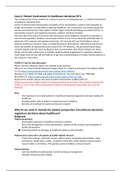Case 6: Patient involvement in healthcare decisions/HTA
The closing session of the conference is about to start on an intriguing topic, i.e. patient involvement
in healthcare decisions/HTA.
Susan is convinced that incorporation of patients in the development, conduct and evaluation of
health interventions is worthwhile to optimize healthcare. She is therefore very excited about this
session and wants to learn more about in which stages of health technology assessment (HTA), i.e.
intervention research and regulatory decisions, patients should be involved.
The first talk of the session from Dr De Wit will present some initiatives of patient involvement in
research and regulatory decisions. Susan hopes further to learn more about the potential roles of
patients in HTA research and regulatory decisions. The second talk from Prof Bridges is about
patients’ preference research. Susan is wondering how to elicit patients’ preferences and to learn
about the benefits of stated-preference research for HTA decisions. She previously heard about
conjoint analysis and best-worst scaling but does not remember what these methods are about.
Finally, the last talk is about how to facilitate optimal patient engagement in regulatory decisions.
Susan hopes that this last talk will help her to get key recommendations to better involve patients in
her research in the future.
COVID-19 Task for Post-discussion
Please read the following articles and respond to the question:
Pitts et al. Our Most Powerful Weapon to Fight COVID-19: Patient Involvement. The Patient (2020)
13:255 https://www.ncbi.nlm.nih.gov/pmc/articles/PMC7160609/
Murphy et al. COVID-19: Public and patient involvement, now more than ever. HRB Open
Res(2020),3:35 https://www.ncbi.nlm.nih.gov/pmc/articles/PMC7327728/
Based on the articles, discuss the value of patient involvement to fight COVID-19.
Patient involvement to fight COVID-19 is important because everyone in the society is impacted by
COVID-19. Due to the active participation of patients and the general population the curve has
flattened.
Aims
- The importance to include patients in healthcare decisions/regulatory decision-making for
healthcare
- Possible patient roles in patient involvement/some initiatives
- Benefits and methods for patient preference research
Why do we need to include the patient perspective in healthcare decisions/
regulatory decisions about healthcare?
Background
Patient perspective
- Increasingly important in healthcare decisions and HTA
- Key in the development (of the intervention), conduct (of the analysis) and evaluation of
health interventions
Involving patients at all stages of healthcare delivery and evaluation
Patients have a key role in all aspects of health-related research
- Trial protocol design, informed consent, ethical review, marketing authorization, value
assessment, health policy, public, competent authorities, policy makers/research policy,
research ethics committees, HTA agencies and committees, clinical research
Clinical decision
- Can help healthcare professionals to improve disease management
- Facilitate shared decision making
, - Improve medication adherence
- More active role of patients in clinical decision making
Policy decisions
- The importance of patient involvement in HTA is becoming widely recognized
- Patients are directly affected by HTA decisions – they are key stakeholders, and have a
‘democratic right’ to be involved
- Patients can provide information and insight, about the impact of their condition and
treatments on their daily lives that is not available elsewhere
- Patients are in a unique position to describe the outcomes that matter to them, to challenge
presumptions about their health
Importance of patient involvement
- Emphasis on patient-centered research through the engagement of patients in
o Identifying unmet needs
o The design and conduct of clinical studies
o Subsequent regulatory assessments
o Post-marketing vigilance and data collection
o Clinical practice guideline development
Value of patient involvement
- May result in research, clinical, licensing, reimbursement, and policy decisions that better
reflect the preferences of stakeholders, especially patients
- Could improve the effectiveness of healthcare interventions by improving adoption of,
satisfaction with, and adherence to clinical treatments or public health programs
- Could improve the quality, relevance and value of HTA
Example: European Medicines Agency
Patients and consumers are involved in a wide range of activities at the agency, including
- As members of the Management Board
- As members of scientific committees
- Being consulted on disease-specific requests by the scientific committees and working parties
- Taking part in discussions on the development and authorization of medicines
- Reviewing written information on medicines prepared by the agency
- Being involved in the preparation of guidelines
- Taking part in the agency’s conferences and workshops





